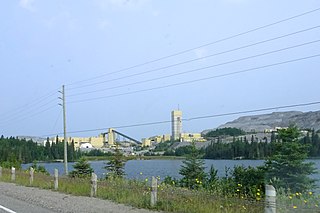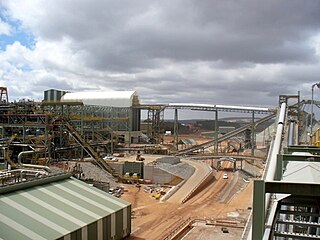
Barrick Gold Corporation is a mining company that produces gold and copper with 16 operating sites in 13 countries. It is headquartered in Toronto, Ontario, Canada. It has mining operations in Argentina, Canada, Chile, Côte d'Ivoire, Democratic Republic of the Congo, Dominican Republic, Mali, Papua New Guinea, Saudi Arabia, Tanzania, the United States and Zambia. In 2023, it produced 4.05 million ounces of gold at all-in sustaining costs of $1,335/ounce and 420 million pounds of copper at all-in sustaining costs of $3.21/pound. As of 31 December 2023, the company had 77 million ounces of proven and probable gold reserves.
Newmont Corporation is an American gold mining company based in Greenwood Village, Colorado. It is the world's largest gold mining corporation. Incorporated in 1921, it owns gold mines in the United States, Canada, Mexico, the Dominican Republic, Australia, Ghana, Argentina, Peru, and Suriname. In addition to gold, Newmont mines copper, silver, zinc and lead.

Newcrest Mining Limited is an Australian-based corporation which engages in the exploration, development, mining and sale of gold and the froth flotation product, gold-copper concentrate. It is Australia's leading gold mining company and its operations have expanded beyond Australia, for example Indonesia, thus becoming a prominent international mining corporation. Newmont initially started the company as a subsidiary in 1966. The subsidiary became Newmont Holdings Pvt Ltd in 1980 and in 1990 acquired 100 per cent of Australmin Holdings Limited taking the current name.
Goldcorp Inc. was a gold production company headquartered in Vancouver, British Columbia, Canada. The company stood among the largest gold producers in the world, employed about 15,800 people worldwide, engaged in gold mining and related activities including exploration, extraction, processing and reclamation. Goldcorp’s operating assets included eleven mines in North and South America.

Lihir Island is the largest island in the Lihir group of islands, 22 km (14 mi) long and 14.5 km (9.0 mi) wide, in Papua New Guinea's New Ireland Province. It consists of a complex of several overlapping basaltic stratovolcanoes rising 700 m above sea level. While the volcanoes are not currently active, geothermal activity is still present. The island is in what was the forearc basin associated with the subduction of the Pacific Plate beneath the North Bismarck Plate. Subduction stopped about 10 million years ago with the collision of the Ontong Java plateau with the subduction zone.

In the United States, gold mining has taken place continually since the discovery of gold at the Reed farm in North Carolina in 1799. The first documented occurrence of gold was in Virginia in 1782. Some minor gold production took place in North Carolina as early as 1793, but created no excitement. The discovery on the Reed farm in 1799 which was identified as gold in 1802 and subsequently mined marked the first commercial production.

Wiluna Gold Mine is an active gold mine operated by Wiluna Mining Corporation near the town of Wiluna, 940 kilometres (580 mi) north of Perth in Western Australia's Goldfields region. Wiluna is one of the Goldfield's great mining centres, with historical production plus current resources of more than 310 tonnes.
Gold mining in Alaska, a state of the United States, has been a major industry and impetus for exploration and settlement since a few years after the United States acquired the territory in 1867 from the Russian Empire. Russian explorers discovered placer gold in the Kenai River in 1848, but no gold was produced. Gold mining started in 1870 from placers southeast of Juneau, Alaska.

Gold mining in Nevada, a state of the United States, is a major industry, and one of the largest sources of gold in the world. In 2018 Nevada produced 5,581,160 troy ounces, representing 78% of US gold and 5.0% of the world's production. Total gold production recorded from Nevada from 1835 to 2017 totals 205,931,000 troy ounces (6,405.2 t), worth US$322.6 billion at 2020 values. Much of Nevada's gold production comes from large open pit mining using heap leaching recovery.

Mining in Ghana is a significant contributor to the nation's economy, accounting for approximately 5% of Ghana's Gross Domestic Product (GDP) and 37% of total exports. Gold dominates the mineral sector, contributing over 90% of total mineral exports. In 2019, Ghana overtook South Africa to become the largest gold producer in Africa, producing 142.4 metric tonnes of gold that year.
Coeur Mining, Inc. is a precious metals mining company listed on the New York Stock exchange. It operates five mines located in North America. Coeur employs 2,200 people and in 2012 it was the world's 9th largest silver producer. In 2013 the company changed its name to Coeur Mining, Inc. from Coeur d'Alene Mines and moved its head office to Chicago, Illinois from Coeur d'Alene, Idaho.

The Carlin Unconformity or Carlin Trend is a geologic feature in northeastern Nevada which represents a period of erosion or non-deposition likely associated with a collision between a tectonic crustal block called a terrane and the North American Plate. The collision occurred during the Mississippian Period, about 350 million years before present. The collision is associated with the Antler Orogeny.
The Telfer Mine is a gold, copper and silver mine located at Telfer on the land of the Martu people, in the Great Sandy Desert of Western Australia. It is owned by Greatland Gold, having been acquired from the previous owner, Newmont, in December 2024.

The Boddington gold mine is a gold and copper mine located 13 kilometres (8.1 mi) northwest of Boddington, Western Australia.
There are different methods by which gold mining companies are ranked. One is by their annual production. Another is by their cash cost per ounce, that is, how much money it costs them to mine the gold. Since gold prices are the same everywhere, companies with lower costs per ounce make more profit. The most common method lists by market capitalization which considers the total value of capital holdings by that company. Also considered when comparing companies is their market capitalization per ounce of gold equivalent which takes the market value and total reserves and resources for each company as well as the price of gold into consideration. The figures for each company can be used to determine the value the stock market gives to each company's reserves on an ounce to ounce basis.

The Cripple Creek & Victor Gold Mine, formerly and historically the Cresson Mine, is an active gold mine located near the town of Victor, in the Cripple Creek mining district in the US state of Colorado. The richest gold mine in Colorado history, it is the only remaining significant producer of gold in the state, and produced 322,000 troy ounces of gold in 2019, and reported 3.45 million troy ounces of Proven and Probable Reserves as at December 31, 2019. It was owned and operated by AngloGold Ashanti through its subsidiary, the Cripple Creek & Victor Gold Mining Company (CC&V), until 2015, when it sold the mine to Newmont.

Tahoe Resources Inc. was a mining company and intermediate precious metals producer with silver and gold mines in Canada, Guatemala and Peru. It was founded in Vancouver, British Columbia by Kevin McArthur, former CEO of Glamis Gold and Goldcorp. Incorporated in British Columbia, Canada, the company's U.S. headquarters is located in Reno, Nevada.

The Peñasquito Polymetallic Mine is the fifth largest silver mine in the world and the second largest in Mexico. It is located in north-eastern corner of the State of Zacatecas and is wholly owned by Newmont. It is an open pit operation which began commercial operations in March 2010, but still managed to produce 13,952,600 ounces of silver that year. Estimated reserves for the Peñasquito Mine are 17.82 million oz of gold, 1,070.1 million oz of silver, 3,214 tons of lead and 7,098 million tons of zinc.
The Marigold gold mine is an open pit gold mine in Valmy, Nevada, 14 miles (23 km) west-northwest of Battle Mountain. The mine is owned and operated by SSR Mining Inc.














